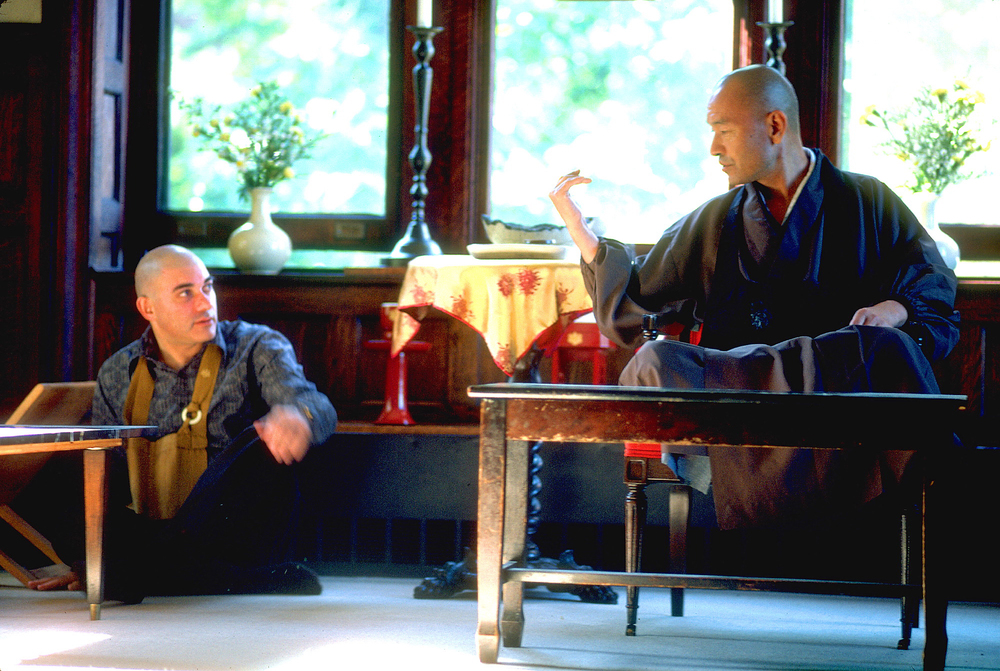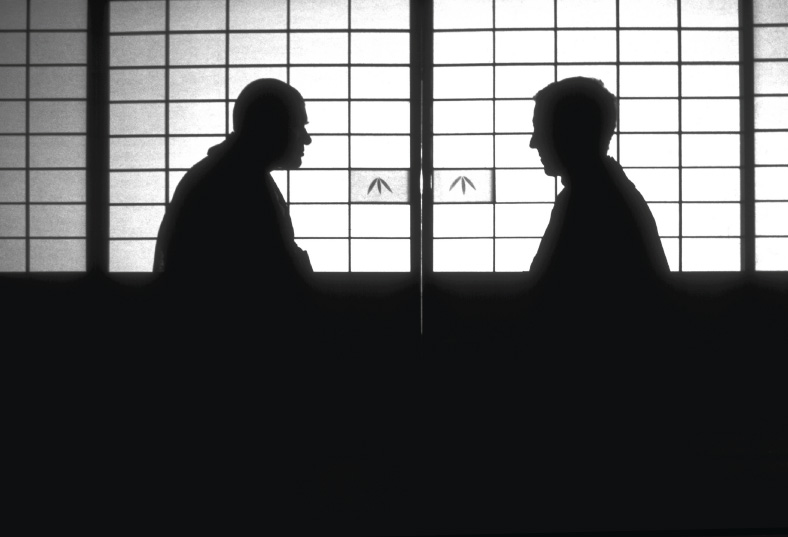
The rain was coming down in sheets as I drove down a wooded road in rural Montague, Massachusetts, towards the opening ceremony of the Maezumi Institute, the new training center of the Zen Peacemakers Order. “The End” by the Doors was playing on the car stereo.
“The West is the best,” sang Jim Morrison.
This song, the opening track of Francis Ford Coppola’s hallucinogenic Vietnam war film, Apocalypse Now, seemed to fit the monsoon-like weather and the destination. After all, the center’s landit was once a farm, bought in 1968, by a collective of anti-war journalists, the Liberation News Service. The group had split away from a harder-edged New York-based political faction to live together and find peace by turning inward. Their credo was “change your mind not just the government.” The farm was also the home of Sam Lovejoy, the leader of the anti-nuclear movement.
The mind likes a nice story arc. It made beautiful sense that this experiment in communal living, awakened activism, and environmentalism would become the home ground for an inclusive and individualistic American Zen dedicated to creating a global interfaith community, and to integrating training and practice with work in the outer world. But I hit a paradox right out of the gate.
The namesake of the institute, the Japanese Soto Zen master Taizan Maezumi Roshi, had been surrounded by hippie seekers after he founded the Zen Center of Los Angeles in 1967. Yet, the tradition Maezumi was instrumental in bringing to the West had been associated in Japan with the samurai, the military nobility. As an institution, it had not opposed the emperor or war. The outcome of the last world war had made Maezumi counter-cultural in the sense that it spurred him to come teach Zen to those most open in this predominantly Christian nation. War had helped make Zen a universal religion, a vehicle for peace.
Our culture particularly loves stories about rugged individuals, remarkable men, visionaries. But Coppola’s movie was a retelling of Heart of Darkness, Joseph Conrad’s tale about Marlow, a man who travels deep into the jungle and encounters the dark inside the light of civilization, the wild inside the tamed. In Coppola’s movie version the remarkable Kurtz, the goal of Marlow’s quest, is a brilliant and highly decorated Green Beret who has gone renegade, crossing the border into Cambodia with a private army and setting himself up as a god among a local tribe. The Marlow figure is to find Kurtz (as played by a huge, bald Marlon Brando, he even looks a little like a Zen master run amok) and—if the rumors are true—“terminate his command with extreme prejudice.”
I didn’t want to assassinate anyone by being extremely prejudiced, and I was acutely aware of my ignorance. I was going to meet Roshi Bernie Tetsugen Glassman, the Brooklyn-born aeronautical engineer who became Maezumi Roshi’s first dharma heir and the founder of an institute that seemed to be very different from Maezumi’s own practice, which emphasized liturgy, koan study, and most especially, Zen meditation or zazen. In Appreciate Your Life, a posthumous collection of teachings,” Maezumi called zazen “the way to practice the Buddha dharma.”
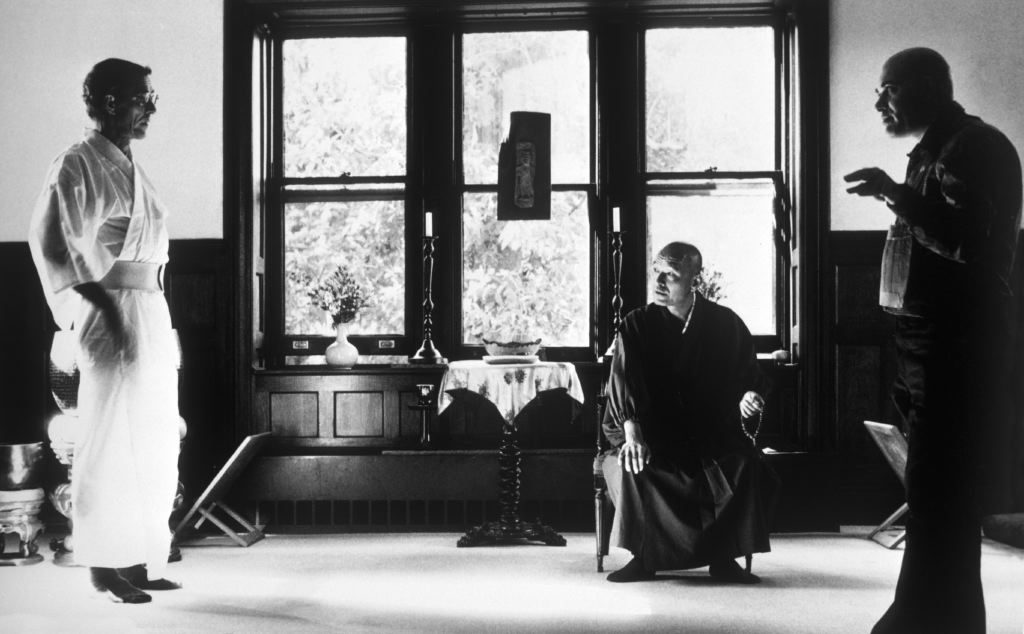
Maezumi had taught an impressive and diverse array of Western students, from John Daido Loori, abbot of the monastic Zen Mountain Monastery in Mt. Tremper, N.Y., to the Zen teachers Charlotte Joko Beck and Pat Enkyo O’Hara, to Michael Soule, one of the foremost conservation biologists in the world. Ultimately, Maezumi established six major Soto Zen temples in the United States and Europe, and over fifty smaller centers. Of all his students and future teachers, however, Glassman stood out as a creator of new, quintessentially American forms, methods, and structures.
In 1982, Glassman founded Greyston Bakery in blighted, unemployment-ridden Yonkers, N.Y. He extended Zen practice into business enterprise and social action, allowing Zen students to work shoulder to shoulder with those whom employers typically shun—the homeless, those just out of prison. Soon this innovative way of practicing Zen flowered into the Greyston Mandala, a web of for-profit businesses and non-profit social service agencies that attracted millions of dollars in public and private support, providing employment and housing.
Not content to prove that the Buddhist way of interconnection can be expressed through the American ways of business, social action, and spiritual values, however, Glassman moved on. He was seemed determined to find ways to use Zen to help heal the world.
Through the Maezumi Institute, people would be offered opportunities to practice in all kinds of places and circumstances, on safari and on the streets with the homeless, even on the grounds of Auschwitz and Birkenau. As I drove, I was pulled between hope and doubt. Was I about to witness a truly American Zen? Or had Glassman been led astray by his ego and his imagination? Could he have gone Kurtz out here on his commune in the woods?
What I was to bear witness to , however, was the profound paradox in Maezumi’s teaching and in Zen practice itself. Seemingly formal, austere, and solitary, Maezumi’s zazen and all his work with students could also be fairly described as wild at heart, aiming for the uncharted wilderness of the present moment.
Maezumi urged his students to be intimate with their real lives, not to wait for some imaginary time when they were perfect to be themselves. He urged them to see that the dharma manifests just exactly where you are, that it is only by seeing who you really are that you can see how you can be of use to the world. He taught them the aim of Zen, that oneness must be actualized in the midst of the unfolding diversity of life.
“Thorough openness itself is the best wisdom,” said Maezumi Roshi.
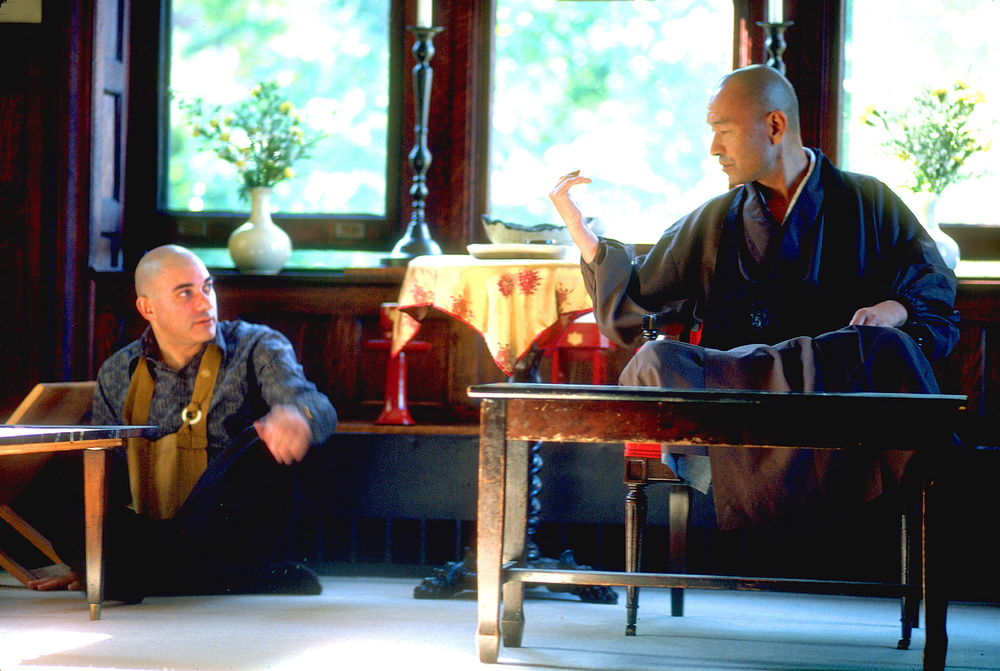
As I entered the soaring “House of One People,” a gorgeously rebuilt and expanded version of the old commune barn, the American Hindu Krishna Das was just finishing singing in his deep, consoling Ganges of a voice. People sat ringed around an altar that included pictures of Maezumi Roshi and one of his recently deceased brothers.
Maezumi’s eldest brother and a younger brother, both Zen priests who had flown from Japan for the opening, took turns performing traditional Japanese liturgies. A memorial poem written and offered by Roshi Pat Enkyo O’Hara, the former Maezumi student who co-directs Zen Peacemakers and who heads the Village Zendo in downtown Manhattan, deepened the atmosphere of elegy.
“It is Mother’s Day,” O’Hara intoned before a crowd that was very aware that Maezumi had died suddenly on Mother’s Day in 1995. This fact was poignant to Maezumi’s students because the Japanese teacher was very devoted to his mother and changed his last name from Kuroda to Maezumi so her family’s name would be carried on.
“The month of May in all its sweet, fresh green, its rose-colored cherry blossoms…. The rain comes and washes the blossoms away—impermanent as our very lives, and we feel and hear the cries of the hungry spirits, ‘help me, save me!’”
The rain pelted the big windows as “The Gate of Sweet Nectar” began. Over the years, Glassman had transformed this Soto Zen rite for feeding hungry ghosts to incorporate elements from Jewish liturgy and Theravada Buddhist loving-kindness meditation. In Glassman’s re-envisioning, the hungry ghosts include all those living people and parts of ourselves who are forgotten or hidden or abandoned. The new ritual expresses the intention to heal.
As I listened, I took in the brightly colored banners that hung all around the rafters of the hall, each of them embroidered with the name of the more than fifty sanghas that haves blossomed from the seeds planted by Maezumi.
At lunch, one after another, Maezumi’s students and family members stood and spoke of his clarity and compassion, of the way he encouraged all his students to be themselves. Peter Gregory, a Smith College professor and provost of the Maezumi Institute, spoke next. He told the crowd he saw the institute as the ripening of Maezumi’s seed vision of bringing the dharma to America.
“Maezumi was telling me over and over that he was the stepping stone and that we had to create the American form,” Glassman told me by phone a few days later.
“The point that Maezumi stressed and that I stress is ‘Keep your eye on the prize,’ “What’s the prize in Buddhism? The prize isn’t a particular form. It’s awakening to the oneness of life. If you know that’s the prize you ask, ‘O.K, how do we help folks awaken to the fact that we’re all interconnected? My interest isn’t just the people who walk into a Zen Center, but all of society.”
“I was trained in the Zen method of koan study,” Glassman continued. “Koans are used to get you to look at life from different perspectives. If you’re aiming at seeing the wholeness or interconnectedness of life, you’ve got to see it from many, many perspectives.”
Traditionally, koans are apparently paradoxical statements or questions designed to help students view reality and themselves in a new way. They cannot be understood apart from a person’s own life, apart the whole of the body and mind, and that seeing is meant to be immediate, mind-blowing. What Glassman is trying to do is create what he calls “experiential koans.”
The first building to be completed on the Maezumi Institute campus, the House of One People, was the dream and the posthumous gift of Lex Hixon, the brilliant polyreligious author and teacher who was a student of Glassman’s at the end of his life.
“Lex and I used to go to a sauna in Yonkers once a week,” Glassman remembered. “One day in the sauna we talked about creating the House of One People and he was going to be the first spiritual director. That was going to happen in Yonkers and then he died. So when we moved to this property and we had the barn, we decided to build the House of One People. This is to be a house of diversity, but showing that within that house you can have events that show our interconnectedness. We already have Monday night Kirtan and Tuesday night Zen and Wednesday night Vespers and Thursday night Zikir and Friday night Shabbat.”
I told Glassman that such an expansive, experimental approach causes some people to wonder if he’s practicing Bernie-ism instead of Buddhism.
“I am who I am so I keep going,” says Glassman. “Many of the things I do don’t work but I need to try.”
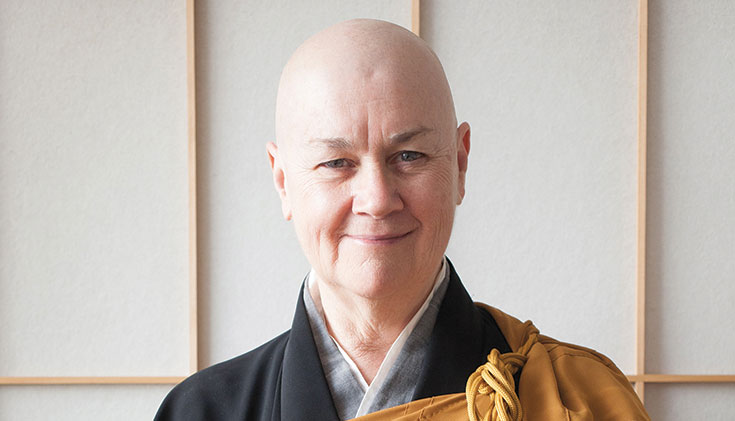
“It seems to me that the heart of Maezumi Roshi’s teaching was for us to really be intimate with who we are and how we can manifest our Buddha Nature in the world,” says Roshi Pat Enkyo O’Hara.
“When Maezumi Roshi first came to Los Angeles, he worked as a priest and a translator at the Soto Zen headquarters of North America. What he loved about the Western people who came to that temple is that they really wanted to practice, not just arrange a funeral or for some other social function but to really, really wake up.”
It is August 2007, and O’Hara is in the midst of leading an intensive, month-long “Ango” retreat for her students at a retreat center on the banks of the Hudson River. A student of Maezumi at the end of his life, she received shiho (dharma transmission) from Glassman in 1997. She received inka (or final authority to teach) from him in an empowerment ceremony held at the House of One People in 2004.
“I did some begging practice when I trained for a time in Japan,” she says. “Old people automatically put money in our bowls. I was struck by that because I knew that would not happen here. It felt good for a short period of time to be in a culture that values Buddhist monastics. On the other hand, what I get here is the tremendous fire in the belly that students have.”
“Zen students have always seemed to me to be self-selected,” says O’Hara. “They come to a difficult practice that involves hours of sitting on a cushion, hours of facing aspects of themselves that are very difficult.”
Educated at Berkeley in the 1960s, O’Hara admits that Zen once seemed too regimented, too authoritarian. She too imagined there could be a “free Zen,” which boiled down to reading about it rather than actually practicing.
“It took a long time for me to see the value of practicing and practicing in community,” she said. “Zen practice is about embracing all aspects of your life, about being alive to whatever is arising, This motionless sitting on the floor that the Japanese are known for is culturally determined, and it’s changing even there. But the real aim is not sitting still. It’s about being quiet inside and learning to have your body be at ease so that your mind can be at ease.”
Yet O’Hara affirms that the traditional forms that Maezumi brought from Japan serve important functions. They are not to be discarded but adapted. “For me, for example, bowing is tremendously humbling and intimate practice,” she says. “It helps me understand that what I think may not actually be the most important thing, and the action of kind of throwing myself down helps me let everything go. When I studied in Japan, much of the time we were doing services. I’ve cut back on the number and length of the services we perform, and the focus is just the change in the quality of our relationships with one another. Sitting is solitary for the most part so we chant to join voices. We do it in English so there is some meaning attached, and sometimes days there do hear the words, and other days there is just sound.” We do it in English so there is some meaning attached.
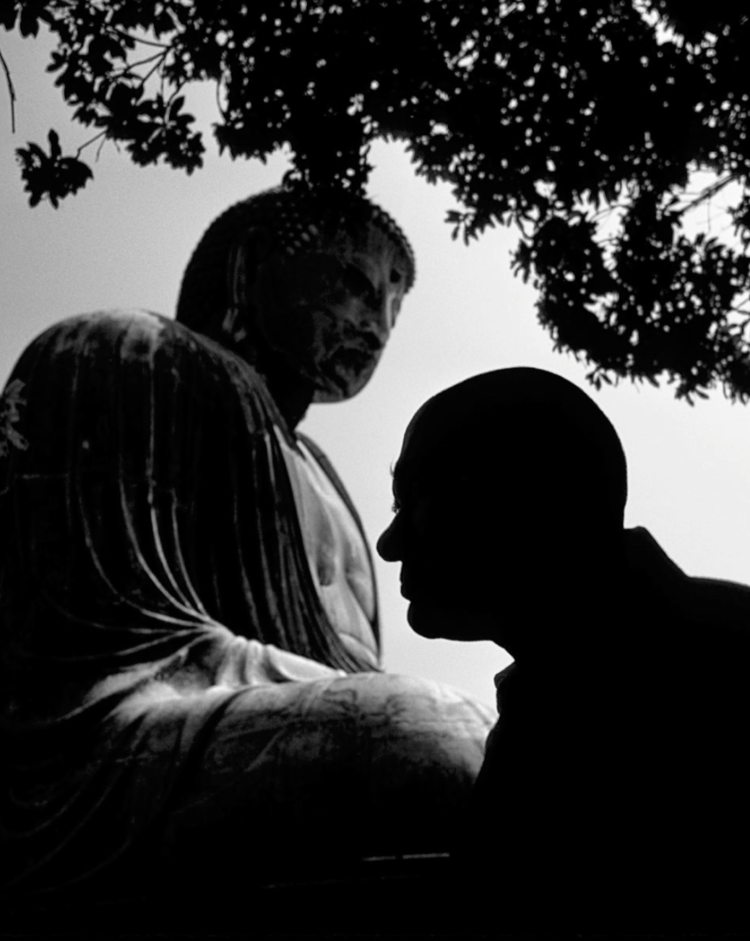
As we sit in the August sunlight, I ask O’Hara how we can learn to practice Zen and study our lives as Maezumi said, no matter what we’re doing in outer life. How can we relate to this ancient teaching in a way that lights up our true situation, that puts us in question, right in the midst of the forms and activities of ordinary life?
“The question is how can we bow without bowing,” she replies. “How do we transform these Japanese forms that some people seem unable to take on? It’s a marvelous question and I’m not sure if I have the answer. For me, folding your body is a perfect way to let go, but I’m very physical. I like the movement of bringing the two arms together, taking two things and making one. It brings me back to an intimacy with myself.”
Regardless of nationality or mind state, assuming certain ancient postures has an action on human beings; the act can evoke the sensation of being present, or even allow a flowering into an awareness of Oneness. Like koans (including Glassman’s experimental experiential koans) the physical practices of zazen and bowing put a person between the poles of faith and doubt—a faith in your experience and your right to bear witness in your life, and the healthy doubt that you know the story.
“It’s the movement between the two poles of faith and doubt that keep you fresh and alive,” says O’Hara. “If you don’t doubt, if you don’t question, then you aren’t really alive. It ’s would be like living in some picture of yourself.”
Yet O’Hara does not preside over a sangha on a mountain top in Japan, but in Soho, in downtown Manhattan, paying rent in one of the highest rent districts in the world. Far from being apart from the world in any sense, her students are lay people who leave work and walk down Broadway, threading their way through the diversity of humanity manifesting the full range of mind states. They take an elevator into a loft space where they enter a state of meditation.
“I love long retreats and monastic places but what excites me and nourishes me is being with lay people in the midst of it all,” says O’Hara. “How do you go right back and make sure a bicycle doesn’t hit you? How can you be awake and intimate with it all, so that you can be compassionate and make a difference when you encounter suffering?”
As a New Yorker and the co-director of the Zen Peacemakers, O’Hara is very aware that we live in a world where one must learn to bow to their tradition without contributing to intolerance.
“There are wisdom teachings from all traditions,” O’Hara affirms. “One thing we do in the Peace Makers is suggest that people study one other tradition. I’ve chosen Yoga teachings, and studying them reminds me that the aim isn’t anything that is called ‘Buddhism’ or ‘Buddha.’ It’s being intimate with your life and being awake and aware of reality.”
Zen meditation can serve as the still point in a turning world, but every tradition has its inner practice of stillness, according to O’Hara.
As the Dedication Ceremony for the Maezumi Institute wound down, an Irish man with silver hair stood up and sang “Danny Boy,” preceding the song with a reminder that the song , which had ironically been written by an Englishman, conveyed the sorrow of a mother saying farewell to a son who was leaving his ancestral home for the New World. Maezumi had done this, and his journey had been as hard and lonely and full of uncertainty as it had been for Danny Boy.
In her biography of the Buddha, religious historian Karen Armstrong emphasizes that when the Buddha left the protected palace of his youth and went forth into homelessness in the yellow robes of the mendicant monk, he was at that time “in the vanguard of change.”
The Buddha was not just personally rejecting his place in the rigid order of Aryan society, according to Armstrong. He was turning his back on an old world in which human spirituality had become a rote exercise in securing magical control over external forces. He set out to find a new world of meaning.
“They were the new men of the era, whose whole lifestyle expressed the heightened sense of individualism that characterized the period,” writes Armstrong in Buddha.
To find the fresh, live truth, the Buddha had first mustered a kind of rugged individuality, quitting his culture, and lighting out for unknown territory. It struck me that Maezumi infused his students with a pioneering spirit, full of faith, doubt, and determination.
After “Danny Boy,” Maezumi’s nephew, Kuroda Taiko, stood up and belted out “My Way” in Japanese: “And now the end is here. And so I face the final curtain. My friend, I’ll say it clear.…I did it my way.”
Hearing this song made famous by Frank Sinatra sung by a monk in robes was very strange, very goofy, yet very right.
“Have good trust in yourself,” Maezumi taught, “not in the one that you think you should be, but the One that you are.” ♦
From Parabola, Volume 32, Number 4: “The New World,” Winter 2007. This issue is available to purchase here. If you have enjoyed this piece, consider subscribing.
